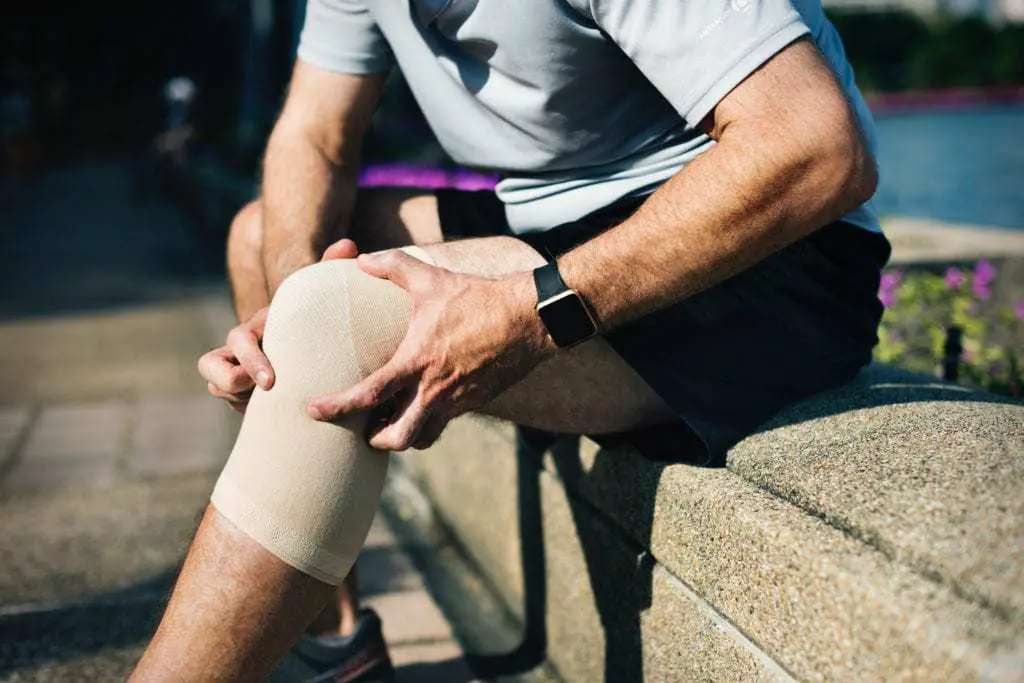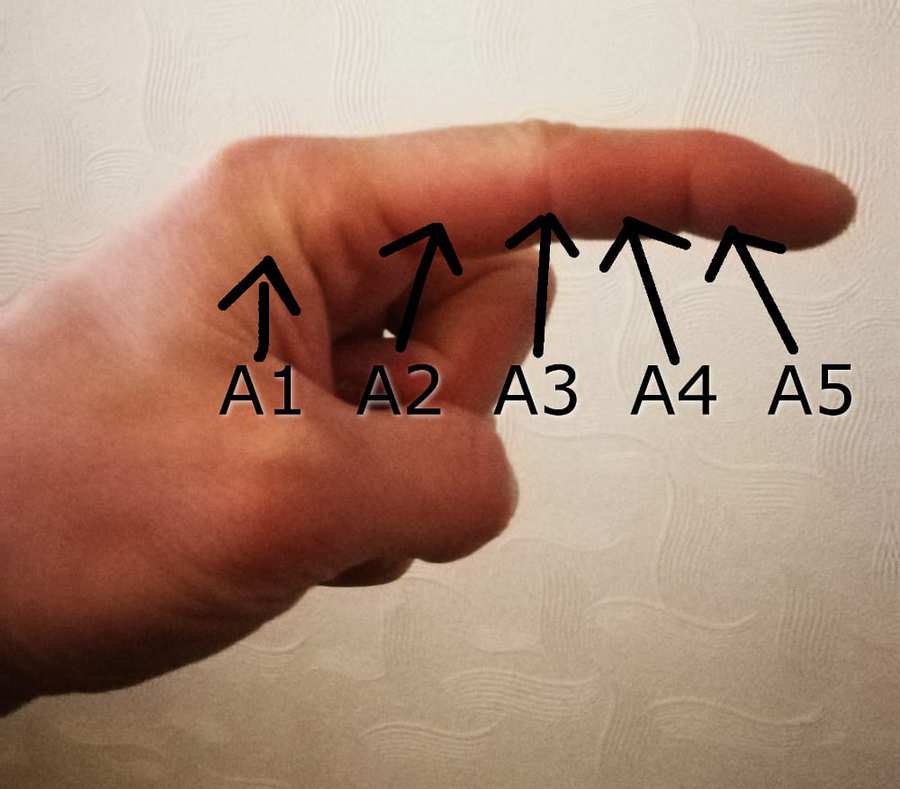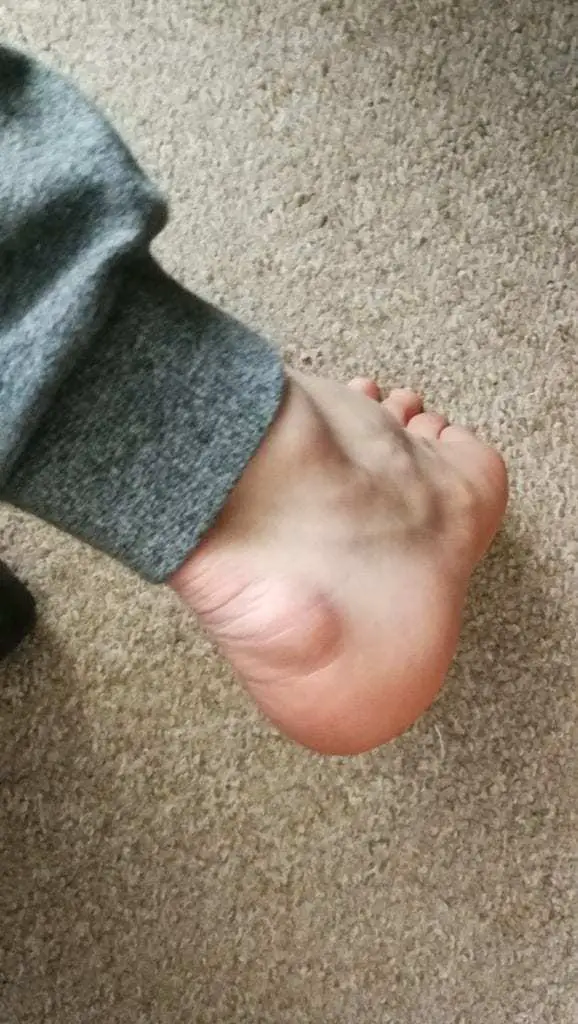
I’ve been climbing for a while now and I’ve noticed I’m injury prone in a few areas. Unfortunately, climbing is a sport where injuries are quite common… although I suppose injuries occur in most sports. I’ve researched into many ways to prevent common climbing injuries from occurring. The places on the body that the most common climbing injuries happen are in:
- The elbow
- The fingers and hand
- The foot
- The wrist
- The knee
- The shoulder
So, how do we prevent the most common climbing injuries from occurring? Most common climbing injuries are prevented by warming up properly, climbing with correct technique, and stretching beforehand. Warming up includes making sure every bit of your body is ready to work, as climbing is a full body workout. This can be done by climbing on very easy grade climbs for around 5 or 10 minutes to get your muscles ready. You can then stretch normally or use the wall and holds to help you. I actually like to use the wall to help me hang myself off a little to stretch my muscles. You should hold a static stretch for at least 20 seconds at a time. Once you get on the wall you should be climbing with as much technique as possible without overusing your muscles and joints. Climbing with the correct technique will take the strain off your limbs and therefore decrease the likelihood of injury. If you are climbing too fast or aggressively, you may also find yourself falling off the wall and landing in a bad way causing injury.
In this article we’re going to cover the common climbing injuries mentioned above and how you can prevent them from happening and repair them if they’re currently affecting you.
Page Jumps
- Common Climbing Injuries: Elbow
- Common Climbing Injuries: Fingers and Hand
- Common Climbing Injuries: Foot
- Common Climbing Injuries: Wrist
- Common Climbing Injuries: Knee
- Common Climbing Injuries: Shoulder
- Conclusion
Common Climbing Injuries: Elbow
The anatomy of the elbow
The elbow is made up of three bones – the humerus, ulna, and radius. It’s a hinge joint on the middle part of the arm. All three bones that make up the elbow are covered in cartilage on the ends which is a rubbery substance that helps the joints move against each other. There are two major ligaments that connect the bones together to make up the elbow. These are the medial collateral ligament and the lateral collateral ligament. The medial collateral is located on the inside of the elbow, whereas the lateral collateral is located on the ouside of the elbow. These two ligaments attach the ulna and humerus together. There is a third ligament called the annular ligament – this attaches the head of radius bone to the ulna bone. There are tendons that attach the biceps and triceps to the elbow bones, and also your forearm muscles to the bones. The forearm muscle tendons are commonly associated with tendonitis.
What causes injury?
An injury in the elbow due to climbing can be caused by changing your whole climbing dynamic. For example, if you are used to climbing very steadily and suddenly change to climbing very aggressively, you may feel more pressure on your elbow region. Even changing from one type of climbing to another can cause an injury in your elbow – changing from lead climbing to bouldering can put more load on your elbow and therefore cause damage.
Acute elbow injuries are usually caused by the flexors of the fingers and the wrist contracting all of a sudden and therefore becoming damaged. Chronic elbow injuries are due to repeating activities over time, eventually damaging tendons and other kinds of tissue.
How to prevent a climbing injury in the elbow
Don’t train too hard. Overtraining can cause both acute and chronic elbow injuries and it’s also not good for you in general. If you’ve taken a few weeks or even months off climbing, recognise this and understand you don’t want to overload your elbows – they aren’t used to it so climb steadily and with proper technique. Warming up and stretching before you climbing is crucial. Lower grades can be used to warm up on or there are simple warm up methods you can do for your arms. Surprisingly massaging your upper back muscles can help prevent arm muscle injury, as well as massaging your arms. If you’ve trained your arm muscles recently, allow some time for your muscles and joints to rest and heal before attempting to train again.
How to treat an elbow injury
Stretch your upper back, arms and shoulders regularly without causing pain on the afflicted area. Rest from climbing if needs be; if you can continue to train then decrease the load or grade. Ice is great for healing most injuries as it reduces swelling. If you need more help with inflammation there are over the counter drugs (ask your GP about these first), or there’s CBD oil. A sports massage may help.
Common Climbing Injuries: Fingers
The anatomy of the finger
A finger contains three hinge joints and three bones. It also contains ligaments that attach to the bones and stabilize them, and tendons that attach the muscles to the bones. A type of tendon called a flexor within the finger attaches to forearm muscles. These muscles tug at the flexor tendons allowing us to bend our fingers and therefore crimp on holds. The tendons are shielded by connective tissue which also allows the creation of 5 annular pulleys: A1, A2, A3, A4, and A5. When a finger is bent, the annular pulleys will keep the bone and tendon close together. Finger injuries are the most common climbing injuries within the hand.

What causes injury?
Finger injuries when climbing can be caused by overuse of the fingers or by a large amount of excessive force applied to the finger. Putting your fingers inside the “screw holes” of an indoor rock climb is a good way to increase the probability of a finger injury. The most common finger injury for a climber is an A2 pulley injury which includes pain at the start of the finger nearer to the palm and hurts when the finger is either straightened and/or bent. A lot of the time a click within the finger can be heard when it’s been injured, followed by pain and swelling. The A2 pulley is mostly involved in crimping which is why it’s more common to injure the A2 pulley more than any other. Dynamic (dyno) moves towards sharp and smaller crimps can cause such injuries, with bad technique and a lot of aggressive movements.
How to prevent a climbing injury in the fingers
Warm your fingers up by stretching and climbing slowly on lower grades for a good 10 or 15 minutes. You can also use the warm down stretches in this article to help you warm up/down before and after a session. Climb less aggressively, use correct technique, and don’t put your fingers in any screw holes to keep your balance, especially the deeper ones – not only is it frowned upon, it can also really injure your fingers.
How to treat a finger injury
Finger injuries can either be minor or serious. These range from sprains to ruptures and tears.
Spraining your finger isn’t too much of a big deal and will usually heal without the need to put it in a splint. An exercise you can perform is to bend your finger tight for 2 or 3 seconds and release. Repeat this 10 times. Do the same afterwards but instead of bending it you now straighten your finger. Do this many times throughout the day.
Partial tears and ruptures of the A2 and A3 pulley or full tears of the A4 pulley require a splint for a couple of weeks and rest until you’re ready to return climbing. Once you’ve returned climbing you should probably wear finger tape when you’re climbing for about 3 months to help strengthen your fingers.
Full tears of the A2 and A3 pulley require a splint to be applied to the injury to keep it immobilized for around 2 weeks. Once you return to climbing, tape your fingers up for around 6 months.
If the annular pulley tears or ruptures you need to see a doctor who will most likely advise surgery.
Ice always helps any swelling.
Common Climbing Injuries: Foot
The anatomy of the foot
The foot contains three sections – the forefoot, the midfoot, and the hindfoot. The forefoot is where the toes are as well as five longer bones known as metatarsals. The midfoot contains a few bones that make up the arches of the foot. The hindfoot contains the heel and ankle. The heel bones, also known as the calcaneus is the largest bone in the foot. On the surface of the foot, there are muscles, ligaments and tendons which help the foot move and keep balanced. One of the more well known tendons is the Achilles tendon, which connects the calcaneus to the calf muscle.
What causes injury?
Most foot injuries caused by climbing are within the forefoot around the toes. This can be due to wearing and climbing in shoes that are too small for you or aggressively planting your toes onto a hold (or both).
If you jump down from the top of a climb regularly, or you just land wrong on your foot as you come down, there is a chance you can sprain or even break your ankle.
Bunions are common in climbing and are only usually painful when they are being pressed on by something such as the inside of a shoe or even the climbing wall itself. I have a bunion on my heel due to wearing shoes that were too tight for me at one point but it doesn’t cause me too much of a problem so I’m not that bothered.

How to prevent a climbing injury in the foot
Foot injuries when climbing can be prevented by wearing the right size shoes. It’s thought by some people that you should feel pain from your shoes when climbing. This is nonsense. Being uncomfortable and feeling pain is completely different. Pain is a signal from the body telling you that something isn’t right an area of your body. This is how I got my bunion; I didn’t listen to my body.
Prevent ankle sprains and breaks by learning how to fall properly – don’t fall onto your foot if possible, especially with a straight leg. And if you are going to jump from the top of a climb (we all do it sometimes), bend your knees as you land to take a lot of the load away from your feet.
Climb with proper technique without digging your toes unnecessarily into the wall or onto a hold – this can cause damage to your toes/feet.
How to treat a foot injury
If you have a bunion that’s annoying you, then you may want to find more comfortable shoes, but you can get them shaved off surgically. However, there’s a big chance a bunion will come back if you continue the activity that caused it in the first place. Any swelling within the foot such as the toes and ankles can be treated with ice and rest. If you suspect you have sprained your ankle or you’ve broken it, you should stop climbing immediately and head to the doctor who can advise you further.
Common Climbing Injuries: Wrist
The anatomy of the wrist
The wrist is made up of the two long bones in the arm discussed earlier – the ulna and the radius – along with a collection of smaller bones called carpus. The ulna and radius are at the top of the wrist. The part of the wrist often injured in climbers is called the Triangular Fibrocartilage Complex (TFCC for short). The TFCC is structured to prevent injuries by stabilising the radial carpal joint and the radio-ulna joint.
What causes injury?
For climbers, the TFCC is most often injured by falling from a wall and landing on your hand in an unsuitable fashion. Injury can also be caused by overusing the wrist when climbing – overtraining can cause many injuries.
When using a hold as a mantle, injuries can occur in the wrist. I’ve actually had this myself on the odd occasion. This is due to the wrist rotating while also being compressed on the hold.
How to prevent a climbing injury in the wrists
If you want to avoid getting wrist injury, learn how to fall properly – don’t fall on an outstretched hand. Overtraining your wrists causes instability in the joint so it’s advisable to finish climbing if your muscles and joints are starting to feel fatigued. If you’re mantling a hold, don’t force yourself up aggressively or too quickly – use proper technique and patience. Don’t forget to warm up and stretch before your climbing session.
How to treat a wrist injury
If your wrist has an acute injury, it may need surgery due to large tears in the tissue around the area. If a bone is broken it will probably need immobilizing with a pot or splint of some kind. Chronic injuries require rest and ice if there is swelling. Over the counter anti-inflammatory drugs can be taken but you should speak to your GP before taking them. It’s also best to avoid any hand holds or movements that aggravate your wrist injury. You would probably be best off not climbing slopers.
Common Climbing Injuries: Knee
The anatomy of the knee
The knee is a hinge joint made up of three different bones: the femur (thigh), the tibia (shin), and the patella (knee cap). There are two types of cartilage that help the knee absorb shock and act as a cushion between the bones. These cartilage are called the meniscus and articular cartilage. There are two types of menisci: medial meniscus which is on the inner side of the knee and lateral meniscus which is on the outer side of the knee. Knee injuries due to climbing often involve a meniscus tearing. The knee also contains ligaments one of which is called the anterior cruciate ligament (or ACL). ACL injuries can also be common in climbing.
What causes injury?
Meniscus tears can be caused by repetitive use of a climbing technique called a drop knee. Drop knees rotate the knee down and cause torque around the knee area creating stress on the meniscus. Aggressive climbing without using proper technique is also another reason for knee injuries. Landing on a straight leg can twist the knee or even cause a ‘knee bar’ which pulls the hinge joint the wrong way.
How to prevent a climbing injury in the knee
If you’re doing a drop knee, try to turn your foot the same way your knee turns. Use proper technique and climb slowly. Warm up properly before you climb and learn how to fall properly without landing on a straight leg.
How to treat a knee injury
Rest and ice are always great for any swelling. More serious knee injuries may require rehabilitation methods including surgery. ACL injuries are often associated with surgery. Meniscus tears and ACL injuries will probably require you use crutches for a while until it’s ok to put weight down on the leg. Some sports stars who have undergone ACL surgery find that rehabilitation through cycling is a very good way to help the injury heal.
Common Climbing Injuries: Shoulder
I haven’t included common climbing injuries involving the shoulder in this article as I’ve done a whole article about that which you can find by clicking here.
Conclusion
Injuries in climbing, as with most sports, are very common but they can be prevented by climbing with proper technique at a slow to moderate pace. Treatment nearly always includes rest and ice. Using the RICE method of rest, ice, compression, and elevation is often advised for any injury where swelling is involved. Some injuries may be more serious than others and might involve surgery and other rehabilitation methods. Once you know the cause of a common climbing injury, you’ll generally know what steps you have to take to prevent it from happening in the first place. If you want information regarding shoulder injuries due to climbing you can click here for an article I wrote.
